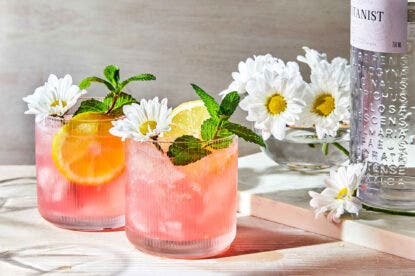Compared to the barrel-aged cocktail trend of years past, bottle-aged drinks are a bartender trick worth stealing to try at home.
Here’s why: It doesn’t involve a barrel or any other fancy equipment, and it can result in a mellower, richer drink, aided only by the magic of time in a bottle. And if you’ve purchased liquor, you already have the bottle, although swing-top options are easy to procure.
But how long can you wait for that drink? A couple of days? A few weeks?
Some bartenders are willing to wait as long as five years.
For Sother Teague, beverage director/bar manager of Amor y Amargo, and co-owner of Coup and Windmill in New York City, what started as a 90-Day Sour turned into a four-year project. It yielded his Four-Year-Old Brandy Sour, now a ritual pour on New Year’s Day.
“What’s interesting is as it ages, the flavor continues to get so soft and mellow,” says Teague. In addition, he says, “it tastes less and less boozy over the years.”
To age a citrus-based cocktail is a bit of a risk, but Teague assures that the alcohol chemically “cooks” the juice, which prevents rancidity. Over time, the mix of brandy, overproof vodka, Demerara sugar and citrus juices (lemon, lime and orange juices) thicken and take on a richer, almost caramelized flavor. Teague likens the appearance and viscosity to mango juice.
“There’s no magic trick, no enzymes or anything I’ve added to the puzzle,” says Teague. “It’s booze and sugar and juice, and let it sit.” He adds one key tip gleaned from canning fruit with his grandmother. “Fill it close to the top, so there’s no oxygen in there.”
Is it possible to age a cocktail too long? “I don’t know!” Teague admits. “That’s why I want to keep doing this.” In the meantime, he has enough of his bottled cocktail to continue aging. Come 2020, he’ll pop open a five-year-old brandy sour.
Nick Bennett, beverage director at New York City’s Porchlight, spends years aging the base egg nog he makes for himself and friends. The recipe begins with eggs and sugar, before he layers on rum, Bourbon, overproof Cognac and “a big pinch of salt.” Milk, cream and nutmeg are added right before serving.
While Bennett says those first sips “took some courage to drink,” he became bolder in subsequent years. He says the egg nog took on a pleasing banana-like flavor by Year Two.
Sometimes, long-term aging is just a happy accident. Scott Marshall, now proprietor of Alley Cat Lounge in Savannah, Georgia, was introduced to clarified milk punch during his previous stint at the Boston bar Drink.
It’s a colonial style of punch that curdles milk with citrus, mixes in alcohol then strains out the solids. What remains is a crystal-clear, shelf-stable drink, a preservation trick particularly useful before the days of refrigeration.
Marshall whipped up large batches of clarified milk punch regularly, which he often decanted into flasks to share with friends. One batch in particular was made with green and yellow Chartreuses, and Batavia arrack, a funky molasses- and rice-based spirit.
In 2011, Marshall brought bundles of the flasks to Tales of the Cocktail, an annual cocktail conference held in New Orleans. He gifted flasks to everyone he came across.
Seven years later, Boston bartender Fred Yarm opened his Chartreuse milk punch and pronounced it “sublime.”
“I’ve never known anyone to keep it more than a couple of months, refrigerated,” says Marshall. “When Fred said he’d held his for seven years, that amazed me.”
For those who don’t want to wait quite that long, Batch Cocktails (Ten Speed Press, 2019) author Maggie Hoffman has a quicker fix: bottled cocktails that are mixed ahead of time and set in the fridge or freezer to age from a few days to a few weeks.
“Even a few days in, you may notice a drink’s flavors seem to integrate and meld together,” says Hoffman. However, if you plan to age a drink for longer than two weeks, she advises to not add bitters until the day you serve the cocktails. Hoffman says that it results in a more balanced, full-flavored drink.
She finds these drinks ideal to make ahead of time to serve at parties, although there’s also something to be said for having a pre-made cocktail waiting in the fridge at the end of a long day.
Assuming you can wait that long, of course.

All She Wrote, an Aged Punch Recipe
In Batch Cocktails, scheduled to be released in March, Hoffman calls attention to this vermouth-based drink contributed by Los Angeles bartender Jeremy Simpson, developed originally for Bestia.
“[It] ages wonderfully in the back of your refrigerator,” she says of this low-alcohol sipper. “Try it after a few months, and you may decide to devote more of your fridge space to a cocktail stash.”
If you plan to age longer than a few weeks, omit the bitters and add 2 dashes to each glass when poured.
Ingredients
2¼ cups Punt e Mes
1 cup plus 1 ounce dry vermouth, like Dolin
3 ounces maraschino liqueur
1½ ounces pamplemousse (grapefruit) liqueur, like Combier or Giffard
⅔ ounce Peychaud’s Bitters
Flaky sea salt (for garnish)
Directions
Batch ingredients at least 2 hours before serving. Using small funnel, pour all ingredients (except garnish) into 1-liter, swing-top bottle. Seal well, and gently turn over-end to mix. Refrigerate.
To serve, turn bottle gently to mix. In rocks glass, pour cocktail over large ice cube. Gently stir before serving. Garnish with small pinch of salt. Serves 12.
Last Updated: May 5, 2023















